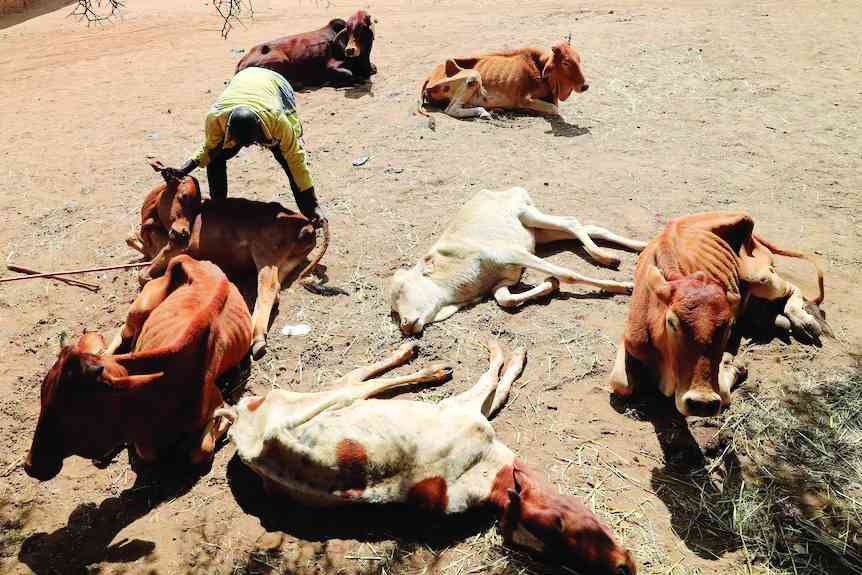
Villagers in Matabeleland North’s Tsholotsho district are struggling to recover from the devastating effects of last year’s El Niño-induced drought, which left thousands of cattle dead and families without food or income.
For communities that rely heavily on livestock for survival, the drought was catastrophic as farmers were forced to watch their cattle die after pastures were depleted and water sources dried up.
Ernest Moyo, a villager from Zikwakweni, spoke about the challenges they faced as a result of last year’s drought.
“The rains were very little, and our cattle had no water,” Moyo said.
“The grazing land was too far, and taking the animals there was a huge risk.
“Hungry predators like lions and hyenas were also searching for food, and some villagers lost up to nine cows in just a few days.
“The meat was too much to finish, so they ended up burning the carcasses. It was painful to watch.”
With no grazing land available, some farmers resorted to feeding their cattle salty sand, while others cut down trees to provide leaves as fodder.
- ED orders chiefs to campaign for Zanu PF
- Rangers move to wildlife ‘hotspot’
- Tsholotsho villagers spend nights up to quench thirsty livestock
- Tsholotsho villagers relive effects of devastating drought
Keep Reading
“Water was another challenge,” Moyo added.
“We don’t have dams here.
“We only rely on small waterholes (machibi), but these dried up within months.
“There was nowhere to take the cattle for drinking.”
Some villagers were forced to sell their cattle at very low prices just to salvage something before the animals died.
“Our cattle are everything to us, but this drought made it impossible to keep them alive,” said Zenzele Ncube, a farmer from Vozheka.
“The grazing lands turned to dust, and even the water sources we relied on dried up.
“Some days, we had to sell our cattle at very low process because we knew they wouldn’t survive much longer. “
The El Niño-induced drought of 2024 was one of the worst in recent years, leaving farmers helpless as their cattle died from hunger and thirst.
As the drought ravaged provinces, farmers were encouraged to destock to avert losses from cattle deaths.
However, destocking is often frowned upon as cattle are seen as a status symbol.
“It’s painful because these animals are our wealth, our food, and part of our tradition,” Ncube said.
Others, like Nkosiphile Sibanda from Sitambali village, described the difficult choices villagers had to make.
“We tried everything—digging deeper wells, cutting down trees for leaves—but nothing seemed to be enough,” Sibanda said.
“The drought also affected our own food supply, so sometimes we had to choose between feeding ourselves or our cattle.
“Those who lost most of their livestock are struggling even more because they have no means to buy food or send their children to school.”
In response to this crisis, Children in the Wilderness (CITW) and the International Union for Conservation of Nature (IUCN) launched the Wilderness Ngamo Livestock Farm and Vocational Training Centre, a project aimed at helping villagers rebuild their herds and adopt sustainable livestock management practices.
The initiative includes Solar-powered boreholes to ensure water availability, predator-proof kraals to protect livestock, sustainable grazing programs, and livestock restocking efforts to support affected farmers.
As part of the government’s livestock restocking programme, villagers have also received cattle from Wilderness to help them recover from their losses.
Chief Matuphula expressed gratitude for the support from Wilderness, which provided livestock restocking, boreholes, and training on sustainable grazing.
“Even though we lost a lot, today we celebrate this support from Wilderness,” the chief said.
“This drought did not just affect livestock—it left many people without food.
“The government has been assisting, and now we hope these rains will allow people to harvest and rebuild their livelihoods.”
Wilderness Zambezi impact manager, Sue Goatley, said the project is not just about immediate relief, but also about building long-term resilience for the communities.
“Strengthening market linkages for farmers. Building an abattoir to enhance income,” Goatley said.
She also highlighted the importance of sustainable grazing training in preventing future crises.
“We are focusing on expanding sustainable grazing training to help communities make the best use of their land while ensuring that they have a steady food supply for their livestock," Goatley said.
“This will reduce the risks of overgrazing and land degradation, which contribute to the severity of drought conditions.”
While the rains have now returned, villagers in Tsholotsho remain vulnerable to future droughts.
Many are calling for long-term solutions, such as construction of more dams to ensure year-round water supply, improved irrigation systems for livestock and crops, climate-resilient farming practices to withstand extreme weather.
“We have learned a painful lesson,” said Chief Matuphula.
“Now, we must prepare ourselves for future droughts so that we don’t suffer like this again.”
Although the scars of the 2024 drought remain, Tsholotsho villagers are determined to rebuild—with hope that projects like the Wilderness Ngamo Livestock Farm will offer lasting solutions to their ongoing struggle.









